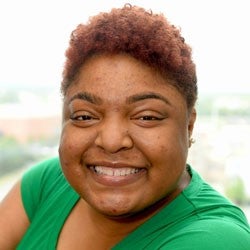Jada Lucas
July 17, 2019Severe Aplastic Anemia, Bone Marrow Transplant
Jada Lucas rarely got sick as a child, so when she suddenly lost her energy and developed unexplained bruises, it was a big deal. “I frequently got tired and wasn’t wanting to do the normal things a 9-year-old would want to do,” said Jada, now age 22. “We thought the bruise was just a spider bite, but my mom took me to the doctor anyway just to make sure.” Lab tests revealed a diagnosis of severe aplastic anemia – a disease in which the bone marrow does not produce enough blood cells for the body. Jada was referred to Children’s of Alabama, where she began weekly transfusions. At times, Jada was in the hospital up to three times a week for treatment. She was eventually pulled out of school due to a weak immune system and homeschooled instead. “It was really hard to understand it all as a 9-year-old,” Jada said. “You just don’t understand at that age. It was a lot to deal with, but everyone at the hospital was always so sweet and helpful. They tried to make everything as smooth and comfortable for me as possible.” Jada also had to come to terms with the possibility of a bone marrow transplant. Doctors tried other treatments first, but nothing worked. She would improve for a few months, then relapse and resume weekly infusions. Doctors tested Jada’s sister to see if she would be a match, but unfortunately she wasn’t. “They finally told me that we were going to have to do a transplant, but they wanted to find the best possible match for me,” Jada said. One day in 2017, Jada was given the news that the right match had been found. “I had really mixed emotions,” she said. “On one hand I was thinking how great it would be for this journey to finally be over, but then at the same time, I was in college and wasn’t ready to take a break from my education.” Jada went ahead with the bone marrow transplant, which went well. After just under two months in the hospital, she was discharged home. While she’s still recovering and receiving treatment for chronic graft-versus-host disease (GVHD) of the skin, she’s preparing to return to college this fall and continue her studies in psychology. She’s also looking forward to finally meeting her bone marrow donor in August 2019 as part of Children’s of Alabama’s partnership with the Be the Match bone marrow registry drive. “I’m very excited to meet him and his family,” Jada said. “I cannot wait to tell him thank you for seeing me as being worthy of a second chance at life. It will be an experience I’ll never forget.”







